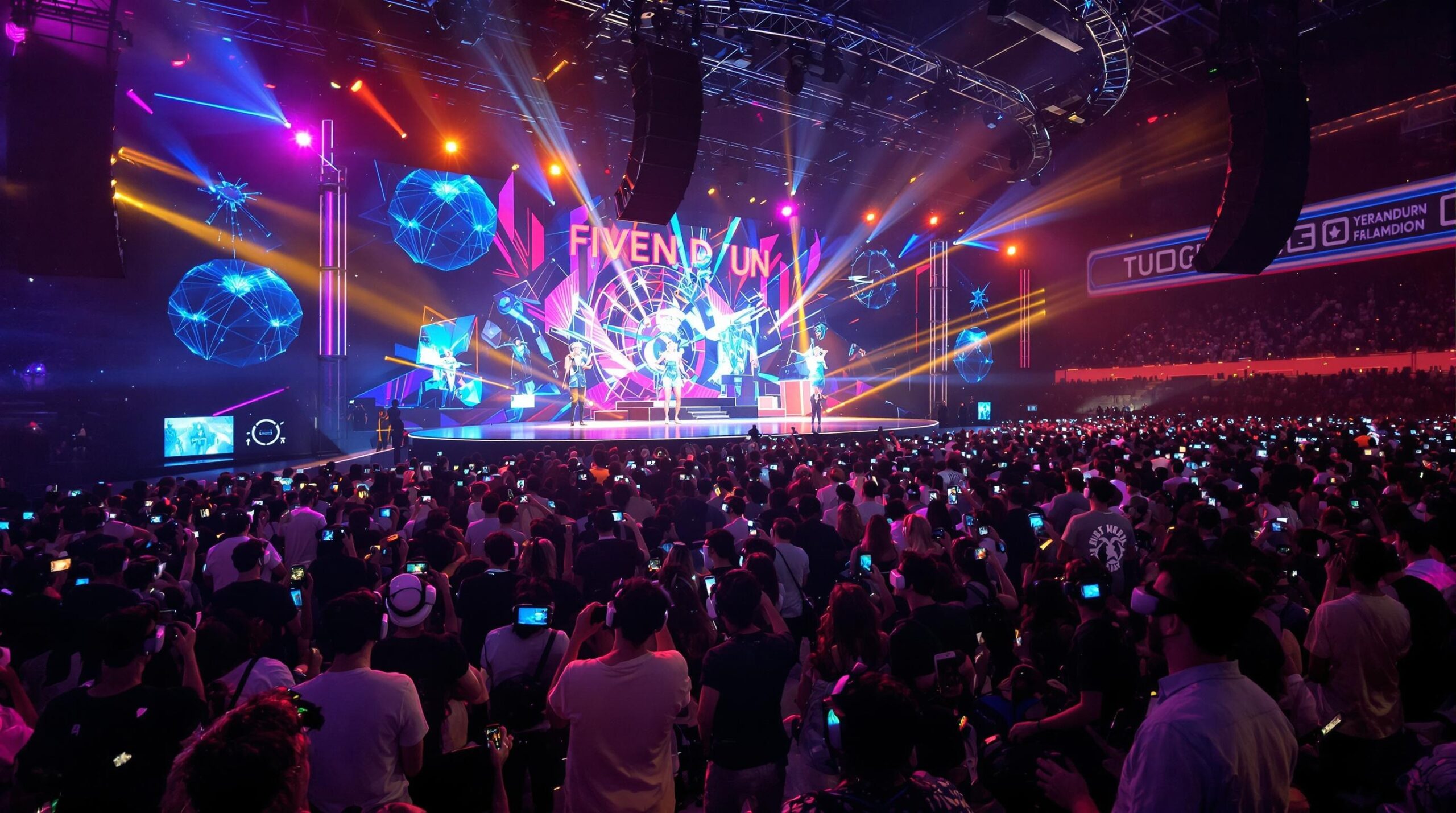The music industry faces rapid technological changes, with artificial intelligence (AI) now at the forefront of live performances. AI-powered virtual concerts have emerged as a groundbreaking way for artists to connect with their audiences. This disruptive approach blends cutting-edge software, immersive digital environments, and real-time audience interaction to redefine what live music means in a hyper-connected era.
The Evolution of Live Music
Live music began with sound reverberating through concert halls and outdoor venues. As decades passed, radio and television broadcasts extended the reach of musical performances. The arrival of the internet allowed fans to stream shows and access music from anywhere. While streaming platforms expanded accessibility, they often lacked the magic and energy of in-person concerts. The COVID-19 pandemic dramatically accelerated digital adoption, pushing artists and promoters to search for new ways to engage their followers.
Virtual concerts became popular solutions, giving fans a front-row seat without leaving home. Early virtual events, however, were often little more than webcam broadcasts. They lacked the energy, spontaneity, and spectacle that define legendary concerts. Artificial intelligence is now closing this gap, enabling richer, more interactive, highly personalized experiences.
What Makes AI-Powered Virtual Concerts Unique?
AI-powered virtual concerts stand out by integrating sophisticated algorithms with real-time data processing. These technologies analyze both the music and audience responses to customize performances on the fly. Virtual stages offer immersive 3D environments where visual effects respond dynamically to the music. AI animates digital avatars of artists and creates new worlds not possible in traditional physical venues.
Participants and performers can interact with each other through chat, voice, and gesture recognition. AI-powered systems moderate these interactions, escalating positive engagement and reducing disruptive behavior. Intelligent recommendation engines suggest songs, merchandise, or experiences tailored to each viewer’s preferences and location.
Enhanced Creativity and Performance
AI enables artists to push creative boundaries during virtual concerts. Sophisticated neural networks generate unique visual effects synchronized with the music, enhancing the sensory atmosphere. AI-driven lighting, pyrotechnics, and backgrounds evolve in real-time, reflecting tempo, mood, or even lyric changes.
Musicians can collaborate seamlessly with AI-generated performers like digital musicians or accompanying choirs. These virtual counterparts learn from the artist’s style and adapt to ongoing improvisations. AI tools also help artists compose music during the event, instantly remixing songs in response to audience reactions. This opens new avenues for audience-driven performances.
Audience Participation and Personalization
Traditional concerts limit audience interaction to applause or the occasional shout from the crowd. AI-powered virtual concerts deliver far more engagement. Through integrated digital platforms, viewers can request songs or vote for encores. The system analyzes live feedback, adjusting setlists, visual themes, or artist banter accordingly.
Each attendee experiences a concert tailored to their tastes, leveraging AI to modify camera angles, sound mixes, or virtual environments. Based on user data, personalization engines recommend exclusive content, backstage tours, or networking events with fellow fans. Fans even participate via their avatars, dancing beside friends or the artist in shared digital spaces.
Breaking Down Geographical Barriers
Physical concerts often confine musicians and fans to specific cities, venues, and dates. AI-powered virtual concerts erase these boundaries. Fans worldwide can attend the same performance simultaneously, regardless of their location. This democratizes access and fosters a more diverse, global community of listeners.
Touring becomes less taxing for artists, eliminating travel expenses and logistical headaches. Musicians can perform virtual concerts for targeted fan bases across different time zones, ensuring no one misses out due to distance or scheduling conflicts.
New Business Models and Revenue Streams
AI-powered virtual concerts are driving innovative business models in the music industry. Ticketing systems leverage blockchain and dynamic pricing strategies, maximizing revenue and fairness. Merchandise sales become immersive, with virtual items such as exclusive outfits, personal shoutouts, or limited-edition digital collectibles.
Sponsorship opportunities expand as brands embed themselves within the digital environment, offering interactive experiences to concertgoers. AI helps match advertisers with audiences most likely to engage, boosting return on investment. Artists gain access to detailed analytics on audience engagement, guiding decisions on future releases and event planning.
Technological Challenges and Ethical Considerations
Despite their promise, AI-powered virtual concerts raise significant technological and ethical issues. Latency, graphical fidelity, and internet accessibility all impact the quality of these digital experiences. Developers must constantly evolve their platforms to ensure seamless interaction and minimize technical difficulties.
Ethical questions arise as AI-generated content blurs the line between human and machine artistry. The authenticity of performances may be questioned when AI manipulates voices, creates avatars, or composes new music in real-time. Privacy concerns grow as virtual platforms collect vast user data to enable personalization.
To address these challenges, industry leaders collaborate on best practices regarding consent, data protection, and creative transparency. Open communication with fans builds trust and ensures an ethical framework. Continuous investment in technology will be vital to offer accessible, high-quality experiences for all participants.
Notable Examples of AI-Powered Virtual Concerts
Several high-profile events have demonstrated the power and versatility of this new concert format. Travis Scott’s “Astronomical” Fortnite concert drew over 12 million viewers to a surreal, visually stunning performance shaped by AI-driven animation. Billie Eilish collaborated with multiple tech partners to stage immersive, interactive concerts adapted to audience reactions.
Virtual K-pop groups like K/DA and Aespa use AI to craft performances and interactions beyond the scope of human musicians. Even legacy artists such as ABBA have embraced this trend, launching “Voyage,” a series of concerts with digital avatars powered by motion capture and artificial intelligence. These examples prove the immense creative and commercial potential of AI-driven performances.
Shaping the Future of Live Music
AI-powered virtual concerts are more than a stopgap solution for times of crisis. They are rapidly establishing a new paradigm for live music. As audiences grow accustomed to immersive, interactive digital experiences, expectations for in-person events will shift accordingly. Artists with AI tools can explore endless creative possibilities while building deeper relationships with fans.
Hybrid models that blend physical and virtual elements may redefine the very concept of live performance. Artists could play in a packed venue while their digital avatars perform for millions online, sharing the same setlist and memorable moments. This intertwined approach may become the norm, creating richer, more inclusive live music ecosystems.
Conclusion
AI-powered virtual concerts have begun to transform the landscape of live music, fusing technological ingenuity with artistic expression. These innovations dissolve geographical limits, foster global communities, and ignite new creative frontiers. As the industry refines its tools and addresses emerging challenges, artists and audiences stand poised to experience music in more vivid, personalized, and accessible ways than ever before. The stage is set for a future where the boundaries between art, technology, and experience continue to blur—offering opportunities limited only by the imagination.


